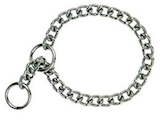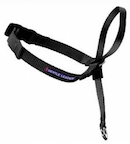
With all the harnesses and collars out on the market today, it is hard to know what will both work and be safe to decrease your dog’s pulling.
Every product seems to claim it can stop the pulling — but without buying everything in the pet store and trying it out yourself, how are you really to know which product will work best?
It can be difficult to choose a product that will work to stop pulling on a leash while not causing the dog discomfort or long-term damage.
Your Basic Collar – Bad
The most common product I see on dogs is the standard flat collar. This collar typically has a buckle and one or two rings to attach the dog’s identification and licenses.
When you are walking a dog that loves to pull, this is probably one of the worst collars you can use. It not only allows the dog to drag you all over, but constant pressure caused either from the dog or the person jerking at the leash can lead to a collapsed trachea.
Choke/Slip Collar – Bad

Other than being harmful by literally choking the animal, choke collars teach the dog how to act properly on a leash through fear, not through positive training methods.
Prong Collar – Best Left to the Experts

Unlike the choke collar, prong collars have limited constriction ability and are designed to constrict only enough to pinch the dog’s skin. When fitted properly, they have a self-correcting effect on the dog.
Again, I do not suggest these to the general dog owner. They are best used when working with a trainer who has experience with prong collars. If fitted improperly and used incorrectly, they can cause immense pain for the dog.
My best suggestion is to keep the pressure off the dog’s neck. Experts have concluded that sudden or continuous pressure upon a dog’s neck can cause serious, sometimes permanent damage to the spine, neck and trachea.
Head Collar – The Best

The head collar consists of two straps, one fitting around the muzzle and the other around the dog’s head. When you connect your leash to the strap around the muzzle, it allows you to lead the dog in the direction you want rather than yanking on the neck.
Head collars also work well for persistent pullers. When the dog tugs, the strap around the muzzle applies pressure to a point that triggers the dog to relax. This instantaneous pressure occurs only when the dog is pulling and thus he learns that he controls the pressure. A head collars is not a muzzle; the dog can pant, eat, drink and bark just as he would normally when it is on.
As great as head collars are, they often require a little training for the dog to get used to. The best way to train your dog to get used to the sensation of a head collar is to allow him to wear it without the leash connected to it every day for about two weeks. I suggest you put it on your dog when you are training him. In this way, he can create a positive association with the head collar.
After the first two weeks, slowly apply pressure to the nose strap each day and move his muzzle from the left and right while offering treats. Once he has relaxed a bit and has gotten used to the head collar, attach the leash and practice walking slowly. The dog will learn quickly that he is completely in control of how tight the nose strap gets.
Popular brands of the heads collar are the Halti, Control Ease and Gentle Leader.
Front Clip Harness – Great Too
[easyazon_image add_to_cart=”default” align=”right” asin=”B004GFSYI0″ cloaking=”default” height=”160″ localization=”default” locale=”US” nofollow=”default” new_window=”default” src=”http://ecx.images-amazon.com/images/I/41HKGa7SvDL._SL160_.jpg” tag=”p51capital07-20″ width=”135″]SENSE-ation No-Pull Harness[/easyazon_image]Another one of my favorite products is the front clip harness. It allows you to attach your leash in between the breast bone of the dog.
Contrast the front clip harness with those that hook between the shoulder blade (“step-in” harness) — those actually encourage pulling; they are made in the image of the sled dog pulling harnesses. But when a dog pulls on a front clip harness, two straps apply pressure to front of the dog encouraging him not to pull.
The front clip harnesses can be used on any age dog and are more easily accepted by the dog than head collars. Two good brands of the front clip harness are the [easyazon_link asin=”B0009ZBKG4″ locale=”US” new_window=”default” nofollow=”default” tag=”p51capital07-20″ add_to_cart=”default” cloaking=”default” localization=”default” popups=”default”]PetSafe Easy Walk[/easyazon_link] and the [easyazon_link asin=”B004GFSYI0″ locale=”US” new_window=”default” nofollow=”default” tag=”p51capital07-20″ add_to_cart=”default” cloaking=”default” localization=”default” popups=”default”]SENSE-ation No-Pull Harness[/easyazon_link]. I typically like to start my client’s dogs out on a head collar and graduate them to an Easy Walk after they learn how to walk calmly on a leash.
When you use products that not only decrease pulling but do not interfere with your dog’s health, you and your dog can have a more enjoyable walking experience.


